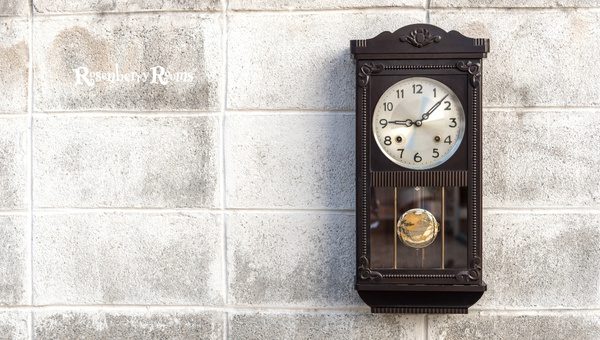Who doesn’t love a statement piece in their home that serves a practical purpose and adds great character to the overall look and feel?
This is precisely what an oversized wall clock can do. With its striking details and impressive size, it can quickly become the centerpiece of your living area, kitchen, or bedroom.
However, finding the perfect oversized wall clock that suits your style and fits perfectly into your interior design can be challenging.
And that’s where the magic of DIY comes into the picture. Making your own DIY oversized wall clock can add creativity and uniqueness to your space. Moreover, it allows you to customize your masterpiece just as you would like.
Contents
Designing your oversized wall clock has several perks. Firstly, it allows you to infuse your aesthetics and creativity.
Instead of shopping for ready-made watches and not finding an ideal match, a DIY project allows you to decide on each detail – from colors and textures to numeral styles – ensuring it complements your existing home décor perfectly.
Creating something with your hands also creates an immense sense of satisfaction. Your customized timepiece will not just fill up that space on your wall but also serve as a conversation starter, a piece that narrates your story.
A DIY oversized wall clock can be economically beneficial as well. A majority of sizable professional-grade wall clocks come with hefty price tags. However, creating one can save money if you're smart with sourcing materials.
It's about the fun! Embrace the joy of making something beautiful out of mundanity. So why not roll up those sleeves and start ticking off this project? It’s time to fall in love with crafting.
Interested? Read On: How To Create Your Own DIY Heart Garland [2024 Latest Guide]

Think of how, before starting a recipe, chefs assemble all their ingredients. The same applies to our DIY project.
Before we jump into the actual process, we need to gather everything that will transform our bare tabletop into an impressive timepiece. This ensures a smooth-sailing project without any hasty shopping trips in between.
Creating a DIY oversized wall clock involves more than just slapping paint on and attaching clock hands. A lot goes into prepping the surface to make sure it lasts long.
The first step in any DIY project involving wood should be sanding. The aim is to have a clean, smooth surface that ensures better adherence to painting and reduces rough spots that might hinder the application of your frescoes.
In our case, we'll start by grabbing our sandpaper or orbital sander and working on the tabletop surface thoroughly until it is evenly smooth to the touch.
While sandpaper works well, an orbital sander can make our lives much easier and quicker. Its round motion ensures an even sanding across our tabletop, knocking off any stubborn spots that hand-sanding may miss.
It’s essential to understand how crucial these initial steps are. Any mishap or shortcut here could affect the durability of our customized wall clock later on - nobody wants their hard work to chip or fade!
Proper preparation ensures that our later steps—staining & painting—go unobtrusively and seamlessly. Remember, every excellent DIY project starts with good prep work.

After smoothing out the tabletop with dedicated sanding, our next step is to stain it. This will give it a more decadent, old-fashioned feel, perfect for our DIY vintage wall clock.
Minwax stain is an excellent product to achieve that rustic, old-fashioned look we aim for. For this project, I've chosen Minwax Stain in Dark Walnut. Its rich color and easy application method make it a favorite for many DIY enthusiasts.
To apply, use a clean cloth and dip it lightly into your can of Minwax Stain. Following along the wood grain, lightly spread the stain over your tabletop. Be mindful not to soak your cloth too much—too much product can result in a splotchy finish.
One coat might not achieve the desired color depth for your DIY oversized wall clock. Wait for your first coat to dry before applying a second coat of stain (or as many as you require). Be patient during this stage - rushing might affect your piece's evenness and final look.
It’s crucial not just to let each coat dry but also to cure properly before moving on to attaching numerals or clock hands. Understanding how wood stain dries can help determine when it's ready.
Typically, drying takes 24-48 hours, depending on temperature or humidity. The curing process might take up to 30 days, which hardens the stain ensuring maximum durability.
The distressed finish or aged look on furniture has become popular in home decoration. Contrary to common thought, achieving a distressed finish isn't about damaging your piece but adding uniqueness to its appearance. This technique involves applying artificial wear and tear to create an aura of age and vintage charm.
A distressed finish creates an effect that resembles the wear caused over time. These pieces usually have shabby spots, faded paint, dents, scratches, or bare wood peeking through their surface - all lending a unique beauty to the piece.
For our DIY oversized wall clock project, achieving this rustic aesthetic will complement the overall antiquated vibe we're going for.
To accomplish this finish, one tool we'll need is sandpaper - it's our key ally. Gently rub along the edges and surfaces of the tabletop where natural wear might occur (edges, corners, etc).
The idea is for some of your wood stains from earlier steps to show through these distressed areas, giving it that naturally aged look.
It's essential to strike a balance while distressing; too rough could result in damage rather than decoration-failure is in over-distressing your piece.
Aim for subtlety; remember that less is more when trying to evoke authentic age and weathering feelings.
So go ahead! Add dimensional character and farmhouse charm with this distressing technique on your DIY oversized wall clock. Just imagine how well this antique-looking masterpiece will blend with your cozy home décor.

Now that we have our stained tabletop looking picture-perfect, it's time to bring in the numbers - the backbone of our oversized wall clock.
To create our numbers, we're going to use Roman numerals. Their vintage, elegant look fits perfectly into the theme of our wall clock. So how do you go about this?
Thankfully, countless Roman numeral stencils available for free on the internet suit various styles and sizes. Some popular ones include stencil designs from StencilRevolution or RapidResizer.
Once you've found a design you like, download and print it. Note that the print scale should be appropriate for your oversized wall clock.
Next comes cutting out your stencils with scissors or a craft knife. When done with this step, arrange the numerals on your stained tabletop in the correct positions according to a traditional clock face.
Remember to space them evenly - an inaccurately paced numeral might throw off the overall effect! A handy trick is to imagine your tabletop as a pizza and place each digit at each 'slice.'
Once you're satisfied with the look, it's painting time! With a tiny detail paintbrush, carefully apply black paint over your stencil.
Choose a good quality black acrylic paint for this job - it has excellent coverage and dries quickly.
When removing your stencil post-painting, ensure it's lifted carefully so as not to smear any wet paint on unintended areas.
However intricate this phase might appear initially, anyone can achieve beautiful results by being patient and taking time.
Now that you've got an impeccably stained surface and beautifully painted numerals, it's time to add functionality to our decorative piece.
Yes, I'm talking about the clock hands. These long slender elements offer more than an aesthetic appeal—they give your oversized wall clock life and purpose.
Your clock hands typically come in three parts—the hour hand, the minute hand, and the second hand. Each one is distinctly different from another in terms of their length and style. It’s essential to familiarize yourself with these differences before installing.
Every clock hands set comes with manufacturer instructions—a ‘manual for mounting,’ to speak. You must follow these steps diligently for safe attachment and accurate timekeeping.
Typically, you'll begin by drilling a hole at the center of your stained tabletop where all your clock hands align.
Then you introduce the hour hand, followed by the minute hand, ultimately sealed with the second hand—ensuring each one fits securely atop another.
Also worth considering are any additional components, such as washers or tiny screws, that might be provided with your sets—they’re designed to provide stability and smooth movement to your clock hands.
Finally—after attaching all three clock hands—we align them correctly. This ensures accurate timekeeping because what good is a surreal-looking wall clock if it can't fulfill its core purpose—to tell time?
Most manufacturers suggest aligning all three hands during setup at midnight or noon. Once your oversized wall clock machine is powered on, dance along as they elegantly glide across beautifully painted Roman numerals on a DIY work of art!
Remember—it’s not just about looking great; it’s also about working great! Get ready to watch how 'time flies' when you're having fun admiring your DIY Oversized Wall Clock.

The final important step in our DIY oversized wall clock is sealing the tabletop. This will enhance the overall finish and shield your creative piece from wear and tear, preserving its charm for years to come.
Polycrylic is your tabletop’s best friend against the test of time. It renders a protective layer against daily wear, moisture, heat, and scratches without altering the wood's natural appearance.
To apply polycrylic:
Polycrylic is relatively easy to use; however, caution should be taken on dripping because once it dries out, drips leave an uneven finish that contradicts our aim for smoothness.
The efficient application helps seal the wood evenly and effectively, providing an aesthetic appeal and a sturdy layer of protection for guaranteed longevity.
The patience you exercised during the staining phase comes back into play here! As the stain needed time to cure before we could handle the tabletop, polycrylic also needs sufficient time to dry properly.
This drying period ensures a hardy finish making it ready for installation onto your wall safely without harming its impeccable surface.
So sit back and allow nature's course while admiring your almost-complete masterpiece—one last step left before you hang it proudly on your chosen wall.
It would be best if you had a circular tabletop, printable Roman numerals, paint, paint brushes, Minwax stain in dark walnut, wood glue, sandpaper or an orbital sander, polycrylic, a drill, and clock hands.
The time will vary depending on your experience level, but generally, you should allow at least two days owing to the drying and curing times for the stain and polycrylic.
Absolutely. Choosing your colors is part of the fun process. Personalizing it helps match your clock with your interior design theme.
Of course! It's all up to your preference. You could even opt for no numbers for a sleek minimalist look.
Using an Orbital sander isn't mandatory; it's just more efficient. If you don't have one, regular sandpaper will work fine.
Creating your own DIY oversized wall clock can initially seem intimidating, especially if you're new to DIY projects.
But as with anything, a positive attitude and willingness to learn will yield great results. Remember, it's not a competition or race.
The beauty of DIY lies within the journey itself - in every strain of effort that transforms basic materials into something unbelievably stunning.
Ultimately, you'll have an aesthetically pleasing wall clock, a memorable experience, and perhaps even newfound passions.
The perfect blend of function and artistry adds class and personality to your home décor. Imagine the sense of accomplishment every time you glance at your unique wall piece to check the time, recalling the joy and creativity that went on during its making process. Time indeed flies when we are having fun.